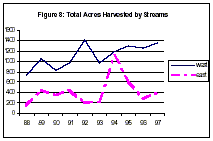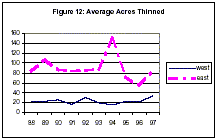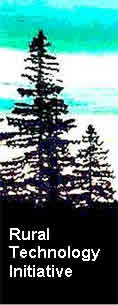 |
Surveys of NIPFs Show Changes in Activity
By Kernen Lien,
WSU Cooperative
Extension, Lewis County
Keeping NIPF lands in forestland uses is imperative for both
a healthy environment and healthy rural communities. Three recent
surveys, the 1997 survey of Washington Farm Forestry Association
(WFFA) members' harvest activities, the 1999 survey conducted
by Washington State University on Washington's forestland owners,
and the 2001 needs assessment survey of Lewis County NIPFs conducted
by RTI, help to characterize NIPFs concerns and changing activities.
All three surveys had similar responses for the size of ownership.
As would be expected most of the NIPFs own smaller tracts of
land. The Lewis County survey found that 50% of the respondents
owned between 20 and 100 acres. Forty-six percent of the WFFA
survey respondents fit into the same category. The Lewis County
mean ownership size was 94 acres. The statewide survey conducted
by WSU showed a slightly larger mean ownership at 115 acres.
|
|
Management Objectives:
The Lewis County survey asked landowners to indicate their
level of importance for several possible management objectives
(Figure 1). Of the top five responses (Privacy, Satisfaction
of Owning Land, Timber Revenue, Legacy for Heirs and Aesthetics)
only timber revenue is a primary economic objective. This
indicates that NIPFs consider much more than economics when
making management decisions. The two lowest responses, Development
and Hunting Leases, suggest landowners are generally not motivated
to convert their forestlands for development or to obtain
revenue from other peoples’ use of their land.
|

Note: Scale runs from Very Unimportant
(1.00) to Very Important
(7.00) with 4.00 being Indifferent. |
|
|
Although Lewis County NIPFs consider more than economics
when making management decisions, when asked to rank management
objectives as first, second and third most important (Figure
2), Timber Revenue turns out to be the most important factor
and Investment is the third most important. Privacy still
ranks high as the second most important objective.
|

| Note: Scale 1.00 is least
important to 3.00 being most important. |
|
Training Needs:
The Lewis County survey also inquired about how landowners viewed
the importance of technical training in regards to the management
of their land. When asked to indicate the level of importance of
a specific training topic (Figure 3), only three categories ranked
above indifferent: Taxes and Estate planning, Regulatory Interpretation,
and Flexibility for Riparian Protection. Categories dealing with
technology were not considered important (a mean response less than
4.00). However, when asked if theywanted more information on training
opportunities offered by RTI, 61% of the respondents indicated they
wanted more information. Of those wanting more information, 81%
preferred to receive the information via mail as opposed to a public
web posting or email. The WSU survey found that 58.1% of their respondents
used a personal computer at home. These figures might indicate that
while owners have access to technology, the use and application
of the technology is limited. This may explain the apparent lack
of interest in technology training. Many of the training opportunities
that were viewed as unimportant provide powerful tools that can
be used in categories that were viewed as important. The technology
may not be viewed as a means to an end. Another reason for the apparent
lack of interest in technology may be that landowners rely on consultants
for technical issues and many of the written comments indicated
such. In a recent survey of consultant needs conducted by RTI, responses
to the importance of technical training were much higher, with 74%
of the respondents indicating that technology training was important
or very important (Figure 3).
|
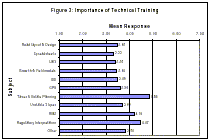
Note: Scale runs from Very Unimportant (1.00)
to Very
Important (7.00) with 4.00 being Indifferent.
|
 |
Harvest Activities:
The WFFA survey focused on harvest activities of its members
over a 10-year period (1988-1997). Figure 4 shows the percent
of acres owned that were harvested.The levels of harvest indicated
by Figure 4 suggest that WFFA members are either harvesting
on longer than economic rotations or not harvesting a substantial
number of acres in their ownership. This should come as no surprise
since, as shown in Figure 1, NIPFs consider a number of variables
important when making their management decisions - not just
economics. Figure 4 also suggests that the small landowner is
just as likely to harvest as the larger landowner since the
percent harvested does not increase with ownership size. |
 |
Another variable entering into the decision of
whether or not to harvest in recent years has been regulatory
uncertainty. Thirty-seven percent of the respondents to the
Lewis County survey indicated they had some sort of regulatory
constraint on their property, while 29% were unsure. The WFFA
survey showed that the acres harvested each year have been on
the rise (Figure 5). The WFFA survey also showed that these
increases in harvest acres did not follow charges in stumpage
prices, indicating that other factors must be responsible. The
WSU survey asked if the landowners had harvested earlier than
planned due to changing regulations, 20% responded yes. |
|
While the total acres harvested are increasing, the type
of harvest is also changing. Figures 6 and 7 show the acres
clearcut and thinned as a percent of the total harvest acres,
as reported in the WFFA survey. While there has been almost
no clearcutting in the east, the percent of harvest acres
that are being clearcut in the west is declining, while the
percent being thinned is increasing.
Much of the change appears to be related to management near
streams. Figure 8 shows the total acres harvested near streams
has been on the rise, while Figures 9 and 10 mirror the trend
for overall harvest activity with the percent of acres clearcut
declining and the percent of acres being thinned increasing.
|
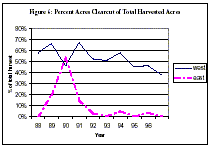
|
| While the overall acres being harvested are on
the rise, the size of the harvest tracks has remained relatively
stable. The harvest unit for the westside is typically 20 acres
for both clearcuts and thinnings (Figures 11 and 12). The eastside
harvest unit for thinnings has remained relatively stable at
82 acres and there are too few clearcuts for a reliable estimate. |
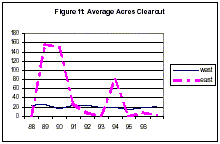
|
The Lewis County survey inquired
about new programs that could ease the regulatory burden placed
on NIPFs; such as the DNR’s Small Forest Landowners Forest
Riparian Easement program (FRE) which compensates landowners
for 50% of the value of those trees left unharvested because
of the new Forests and Fish Regulation, and the Family Forests
Conservation Project which seeks to provide a programmatic Habitat
Conservation Plan (HCP) offering regulatory stability by providing
a long term, scientifically defendable management plan. The
awareness of both programs was quite low with 65% being unaware
of the Forest Riparian Easement program and 71% being unaware
of the Family Forest Conservation Project. However, as shown
in Figure 13, landowners are quite interested in both programs.
Figure 13 shows that 60% of the respondents are willing to try
these programs to ease their regulatory burden with another
20% interested in the programmatic Habitat Conservation Plan. |
| Small forest landowners are a vital
and important part of rural communities. The surveys have shown
that although timber revenue is an important factor in management
decisions, non-revenue factors such as privacy, aesthetics,
and habitat are also very important in decision-making. New
regulatory constraints are making it increasingly difficult
for the small forest landowner to operate, and although landowners
would prefer to let the consultants tackle new technologies
in forestry, they are quite interested in how programs such
as the FREs and HCPs may ease some of their burden. In trying
to adapt to the changing regulatory environment, landowners
are adjusting the way they go about managing their land. While
harvest unit size is stable, the activity is changing, with
thinnings increasing and clearcuts decreasing, particularly
along streams. |
 |
|

|
RTI’s objective is to use better technology to manage
forests in rural areas for increased product and environmental
values in support of local communities.
|
|
RTI Director’s Notes
By Bruce Lippke
We continue to work on the priorities set by our Rural Advisory
Board including some changes in emphasis in this, our second
year.
Our case studies on the impact of the Forest and Fish regulations
on small nonindustrial owners continue to receive attention
(the feature article in the last newsletter). The disparity
in impacts demonstrated by our case studies is being acknowledged.
Under the state’s Forest Riparian Easement program, the
cost of timber cruises will be paid for by the state. Also,
the threshold in revenue loss above which 100% compensation
will be provided to small owners has been reduced to 19%on
the westside, a favorable interpretation of the Small Business
Economic Impact Study findings. There would also appear to
be a broader recognition that alternative plans need to be
allowed to address the many situations where uniform regulations
do not reflect the best practices to reach desired future
condition objectives. Nevertheless, the complexities of management
alternatives under the rules are immense and we are expanding
the list of case studies to cover a wider range of regional
situations.
We have completed the evaluation of a needs survey covering
forestry consultants and a pilot study in Lewis County covering
non-industrial private forest landowners. The findings from
these surveys are the topic of our feature article begnning
on page 1. These surveys show that there is a desire for better
technology by landowners if it can assist in regulatory relief
and that forestry consultants believe that advances in technology
will enable them to better serve their customers.
A 1998 harvest activity survey of WFFA members that we recently
analyzed also shows that their management practices appear
to be very sustainable with harvest levels less than 1.5%
of the total acreage each year from 1998 to 1997. They have
increased thinning activities while decreasing clearcuts near
streams. All are measures of good stewardship and these trends
seem consistent regardless of the size of the tree farm.
|
We have completed a number of training programs
featuring the Landscape Management System (LMS), a versatile
forest inventory and planning software developed under Professor
Chad Oliver, College of Forest Resources, UW, that can simulate
and provide visualizations of future forest conditions; LMS
is the only software of its type available to the public by
web download or compact disk at no charge. We have also expanded
the training coverage to include Geographical Information Systems
(GIS) and Global Positioning Systems (GPS). These tools provide
foresters with useful electronic mapping capabilities. Training
sessions have been very well received by NIPFs, forestry consultants,
and tribal foresters. A schedule of our training offerings is
shown on page 5.
We continue to make progress on developing habitat suitability
models linked to stand conditions resulting from management
changes. We expect these models to be very important in the
development of a variety of adaptive management plans including
small owner habitat conservation plans and other alternative
plans that are anticipated under the Forest and Fish rules,
and tribal resource plans.
A substantial new effort has been launched to assist the Small
Forest Landowners Office (SFLO) in developing a database on
small forestland owners that was mandated by the Legislature.
There is no data standard for county level parcel data or GIS
data. As a consequence it is not currently possible to provide
reliable reports to the Legislature on either how important
the non-industrial lands are to the state, or how they are being
impacted by regulations. In order for the SFLO to represent
small owner interests it must be able to provide more informative
reports to the Legislature.
Perhaps of greatest importance is the increasing caliber of
faculty, staff and student support we are able to put on case
studies and other projects. At the College of Forest Resources
UW, Luke Rogers, Kevin Ceder, and Jim McCarter are the latest
staff members on the team. Luke is finishing his Masters degree
in Forest Engineering with expertise in GIS systems. Kevin Ceder
is about to receive his Masters degree in Silviculture and has
been a pioneer in our habitat modeling. |
Jim McCarter is completing his Ph.D. in Silviculture
and has been the lead developer and trainer for the Landscape
Management System. Their presentations at the WFFA annual meeting,
SAF meetings, training classes and other events have produced
very positive feedback. They have been assisted by Kevin Zobrist,
a Masters student in Forest Economics providing economic impact
analysis, and Jason Cross, a Masters student in Silviculture
providing math models characterizing the impacts of management
alternatives on instream functionality.
In the Natural Resource Sciences Department at WSU, new projects
are developing under the guidance of nine resident and extension
faculty and their students and assistants. John Bassman is working
on eastside forest carbon sequestration which will allow us
to extend other work underway for the westside; Matt Carroll
and Keith Blatner are addressing community and landowners concerns
on fire; and Peter Griessmann is working with private consultants
and others on our eastside riparian impact case studies. Barry
Moore, a limnologist, is studying the effectiveness of riparian
buffers. A standardization technology analyzer is under development
by wildlife nutrition experts Morris Silber and Bruce Davitt.
Tom Brannon, Dave Baumgartner, and Jim Freed continue to work
on road publications. And Kernen Lien, working with Steve Webster
continues his riparian and HCP projects in Lewis County.
While there is much more that needs to be done, we have developed
a very capable support base and are interested in your feedback
on the newsletter, our training programs and presentations,
or issues that need to be addressed. If you are interested in
a more detailed report of our activities, please contact us.
Bruce Lippke, Director
Email: rti u.washington.edu u.washington.edu
(206) 616-3218 |
|

|
Many Benefit from RTI Technology
Training
An important priority for the Rural Technology Initiative
is the development and transfer of affordable forestry
technology. When RTI surveyed 106 Washington Forest
Consultants in the spring of 2000, 80% responded
that… technology training represents an “important
to very important” opportunity for their business to
be successful in delivering services to their customers.
Courses can be customized to tribal and other group
needs and some scholarships may be arranged. A
calendar of training opportunities is posted on the RTI
web site at www.ruraltech.org.
Brochures advertising
training opportunities are mailed out to foresters and
tree farmers across the state. The Society of American
Foresters certifies all RTI training.
In March Frank Shirley, tree farmer, wrote to us,
“I woke up the day after the ArcView course finished
all pumped up and ready to go. It was a good feeling that
I don’t often have after attending short courses.”
The following is the schedule for future short courses:
September 2001– Geographical Positioning
Systems,
Eatonville.
October 2001 – Intro to ArcView, Port Hadlock.
October 2001 – Landscape Management System,
Pullman.
November 2001 – Advanced GIS for Resource
Managers, Eatonville.
November 2001 – LMS, location to be announced.
For more information contact Larry Mason at 206-
543-5772 or by email at larrym u.washington.edu u.washington.edu
|
State Offers Program to Assist Small
Forest Landowners
Under a new program offered by the Washington State Department
of Natural Resources, small forest landowners may now receive
partial compensation for the trees they must leave along streams
and rivers in order to protect water resources. Acknowledged
as a first of its kind in the country, the Forestry Riparian
Easement Program provides monetary compensation to small landowners
who are disproportionately affected by new forest practice
rules. According to the state Legislature’s Salmon Recovery
Act of 1999, forestland owners must provide long-term, protective
habitat for salmon and more than a dozen at-risk fish species
that are impacted by logging, road building, and other regulated
forest practices across nearly all Washington counties.
The rules authorize the Department of Natural Resources to
purchase 50-year easements from qualifying landowners to protect
harvestable timber near fish-bearing streams and other aquatic
areas. To administer the program, the Small Forest Landowner
Office has been established within the Forest Practices Division
of the Department of Natural Resources. The Office serves
as a focal point for small forest landowner concerns and issues.
By actively engaging the public, the Small Forest Landowner
Office is working to create and promote incentives to help
small landowners keep their land in forestry use, and continue
their contributions to public values.
For more information on the Forestry Riparian Easement Program
and other assistance provided by the Small Forest Landowner
Office, please call the Office at: (360) 902-1389, e-mail
at: sflo wadnr.gov,
or visit their website at: www.wa.gov/
dnr/sflo. wadnr.gov,
or visit their website at: www.wa.gov/
dnr/sflo.
|

Readers may send comments to:
Bruce Lippke, Director RTI
CFR, University of Washington
Box 352100
Seattle, WA 98195-2100
Phone: 206-616-3218
email: RTI u.washington.edu u.washington.edu
Janean Creighton, Editor RTI News
Department of Natural Resource Sciences
Washington State University
PO Box 646410
Pullman, WA 99164-6410
Phone: 509-335-2877
email: creighton wsu.edu wsu.edu
|
|















